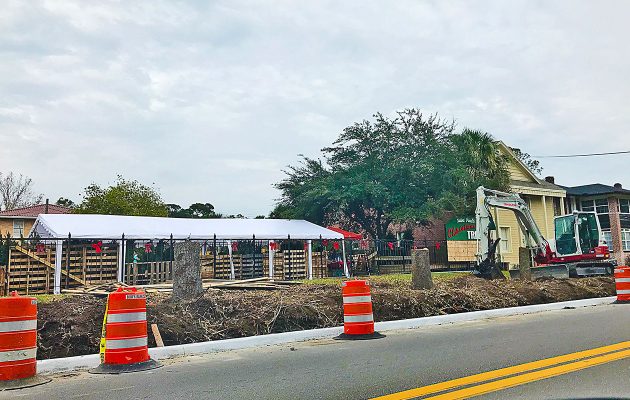‘Tony’ trees removed to make way for Orange Line bus stop
Posted on January 4, 2021 By Editor Neighborhood News, Riverside, Avondale, Ortega, Murray Hill, Top Stories

More than one Riverside resident has been mourning the demise of three mature live oak trees that were removed from the city right-of-way between the sidewalk and Park Street near St. Paul’s Catholic School in late November. The trees were removed by the Jacksonville Transportation Authority (JTA) to make way for a new bus stop that will serve Orange Line riders of JTA’s First Coast Flyer, the final line in a network of four color-coded lines in the city’s large Bus Rapid Transit (BRT) system, said David Cawton, a spokesman for JTA.
“I drove by and was shocked to see them tearing at them with a backhoe,” said Troy Miller, a Riverside resident who remembered when the trees were planted 25 years ago. “I’m a tree hugger. I loved those trees, and I love this neighborhood. The trees were part of the fabric of the community, and they were unique,” he said. “I don’t like to see the destruction of trees in any way, shape or form.”
The trees that were removed were more than just average live oaks, Miller said. They were “Tony” trees, planted in October of 1995 by Richard Ceriello and Greenscape in memory of Ceriello’s partner Tony O’Connor, a longtime Riverside resident.
Before he passed away, O’Connor had been concerned about old trees in the Riverside community that were dying and not being replaced, Miller said. O’Connor started a tree-renewal project, donating $5,000 to have 300 trees planted in the Riverside community, which is why they were called ‘Tony’ trees,” explained Ceriello, who continued the tree-planting work after his partner’s death. “We gave out 150 trees at his funeral to all in attendance,” Ceriello recalled.
The removal of the three trees was included in the permitted plans,” said Cawton. “The three trees will be replaced with four new live oak trees, and a strata-vault system beneath,” he said, adding that the new bus stop will include a shelter and a totem, a digital display that shows real-time passenger information such as schedules to BRT riders.
Since 2015, JTA has been working on the First Coast Flyer network, a bus service that is meant to offer customers a faster ride, fewer stops, and the latest amenities. The system consists of four color-coded lines. The Green Line connects the Jacksonville Regional Transportation Center (JRTC) at LaVilla to JTA’s Armsdale Parks n’Ride near Lem Turner Road and I-295. The Blue Line opened shortly after in 2017 and follows Philips Highway from JRTC to the Avenues Walk Park n’Ride. Two years later, in 2019, the Red Line opened to connect Downtown with Jacksonville Beach. Meanwhile, the Orange Line, JTA’s final route, will connect JRTC at LaVilla with the Orange Park Mall area via Park Street and Blanding Boulevard, Cawton said. “The JTA Route 5 somewhat mirrors that route today, albeit with more stops and a less direct path,” he said, adding that once completed, JTA will have the largest BRT network in the Southeastern United States at 57.7 miles.
The total cost of the entire BRT system is $137 million, with approximately $88 million coming from United States Department of Transportation grants, he said.
“The Orange Line is approximately 13 miles long and will include 22 branded stops and stations, a mile of bus-only lanes along Blanding Boulevard, and traffic-signal priority in various locations,” Cawton said. “Our First Coast Flyer stops always include a shelter, and some include real-time passenger displays, ticket vending machines, bike racks, and larger shelters.”
The Orange Line will open by Sept. 2021. The buildout is approximately $33.2 million, with funding split between JTA at $8.3 million, the U.S. Department of Transportation Federal Transit Administration at $16.6 million, and the Florida Department of Transportation at $8.3 million, he said.
Construction on the Orange Line began in October 2020 and will continue through 2021. JTA has been working with Riverside Avondale Preservation to ensure bus shelters will be consistent with the historic landscape of the community and that includes the Park Street stop, Cawton said.
But his words are of little consequence to Miller, who was particularly annoyed that he needed to call several city officials before finally learning through an email from Brooks Dame, executive assistant to District 14 City Councilwoman Randy DeFoor, that the tree removal was part of a JTA project.
“I’m just really angered, disappointed and frustrated that there wasn’t a public hearing about this project,” he said. “I think this shows there are inconsistencies in the City’s policies. That’s a major project that is causing destruction. It’s killing three mature oak trees. There should have been a sign posted saying there was to be a public hearing, or there should have been something posted to allow people to know what’s going on. It all just happened under the table. No one in the city seemed to know what was going on with this project.
“From my humble perspective, why is it necessary to take down three mature trees to put in a bus stop for this Orange Line when they just removed concrete pads from in front of an apartment building right nearby?” Miller continued. “That stop could have been built right there and saved the trees.”
By Marcia Hodgson
Resident Community News




 (No Ratings Yet)
(No Ratings Yet)




